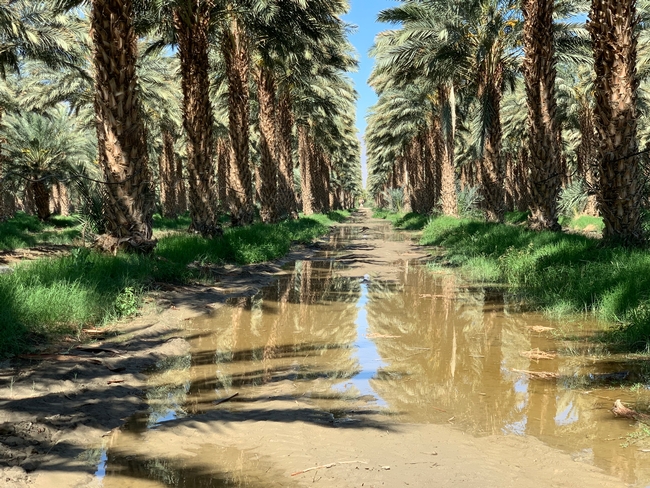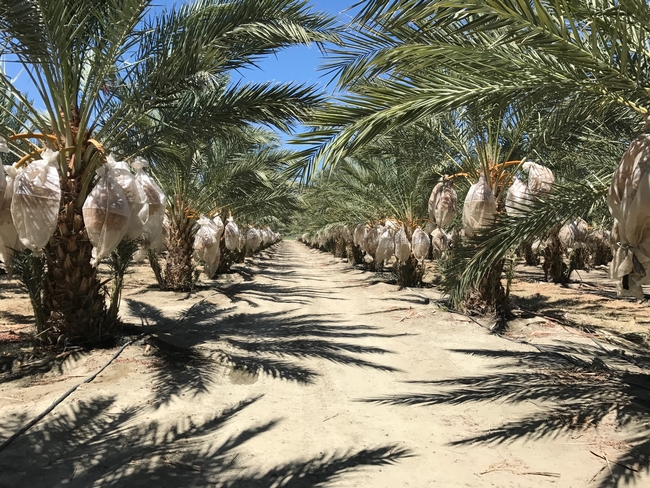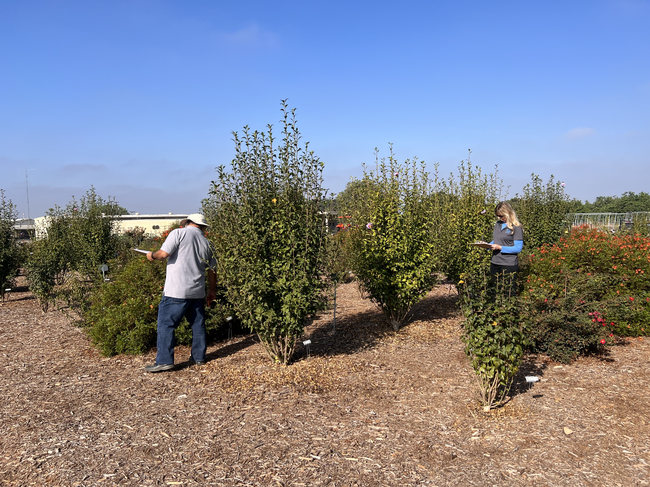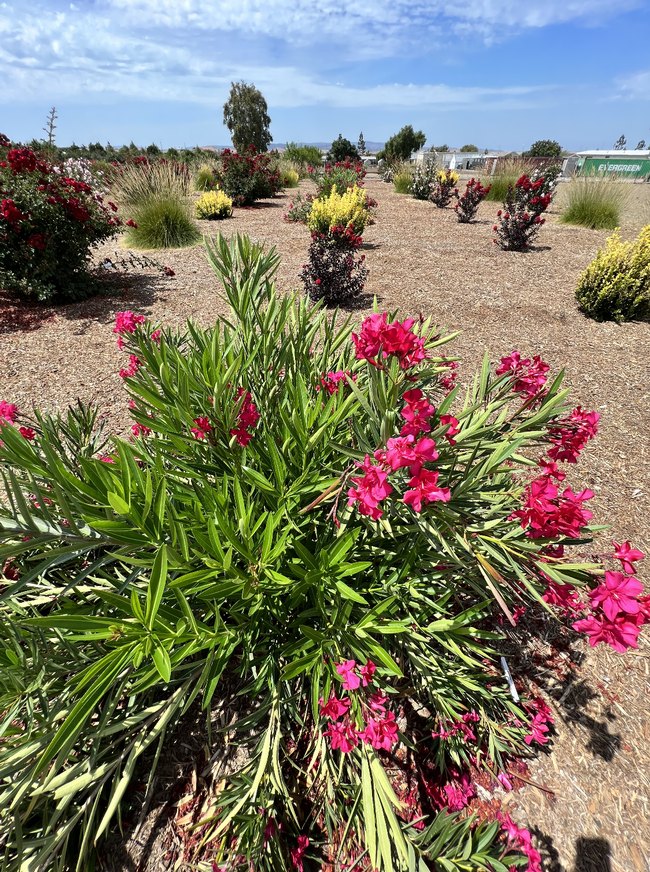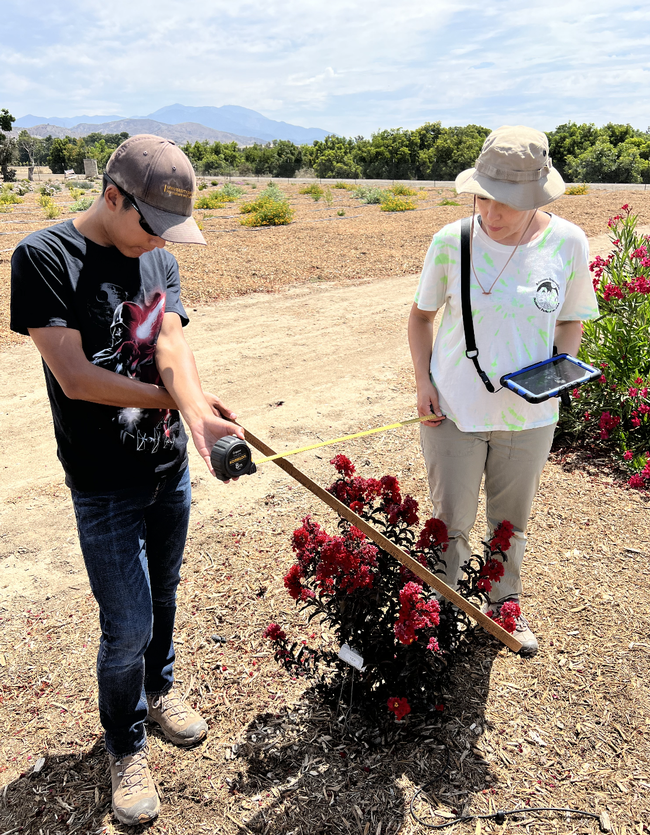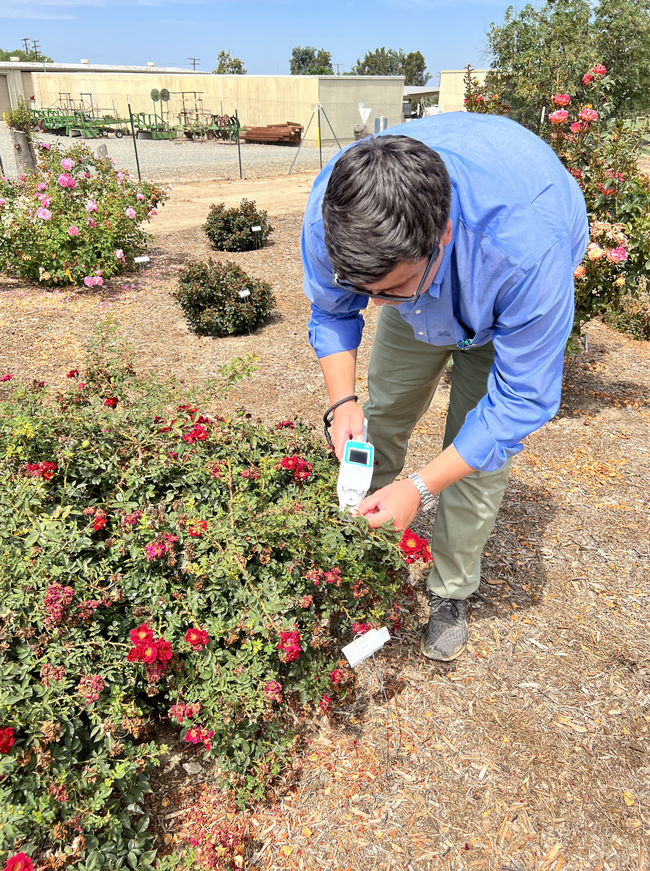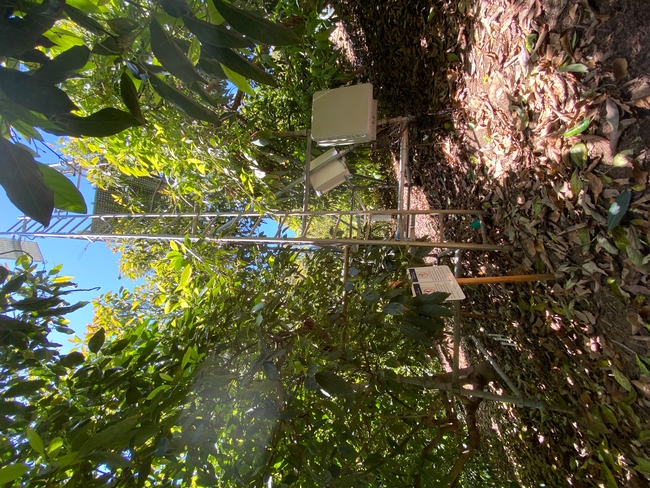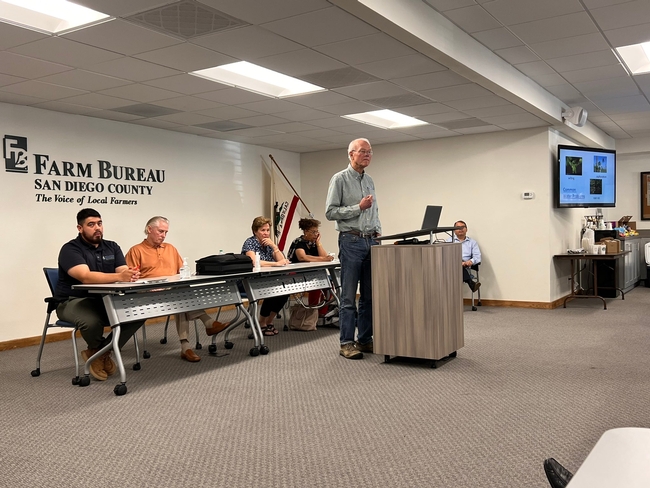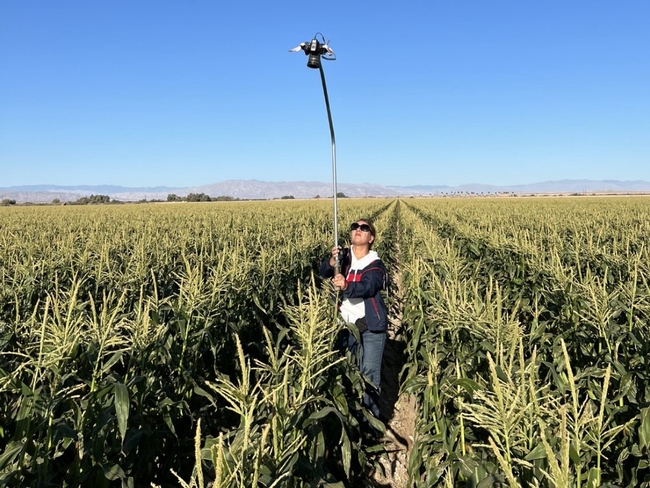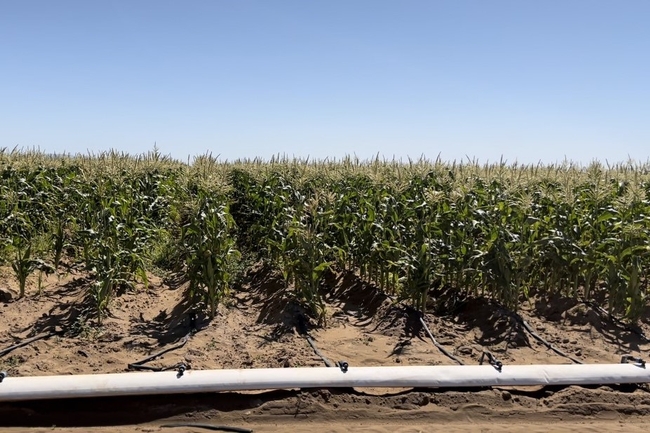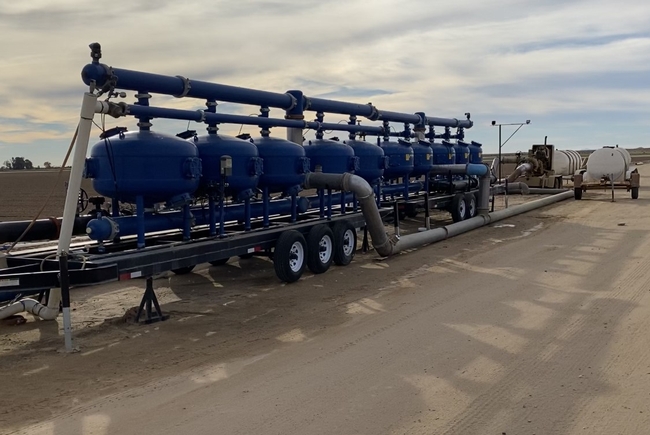Posts Tagged: irrigation
Date palm irrigation research provides economic, environmental benefits
Historically, date palms are grown along riverbeds or in areas with groundwater because they require an abundance of water to produce a good crop. Unlike lettuce or table grapes, date palms are deceptive in that they do not immediately wilt if underwatered. Eventually, however, the lack of water hurts yields and fruit quality.
The default for date growers is to apply excessive water, but doing so is neither economically nor environmentally sound. To help growers, Ali Montazar, UC Cooperative Extension irrigation and water management advisor for Imperial, Riverside and San Diego counties, has developed knowledge that enables growers in the region to establish irrigation guidelines they can use with confidence.
“Water issues in California's desert are very different than in the Central Valley,” said Montazar. “There is no groundwater to recharge so growers in the desert only have the Colorado River.”
Since 2019, Montazar has been focused on irrigation management for date palms in the Coachella Valley, the largest producer of dates in the United States. Montazar's research identifies how much water is needed for the crop and the best water delivery method according to location, soil type and conditions, and date cultivars.
“Dates require a lot of heat and light, which is why they do well in the desert. But they also need a fair amount of irrigation,” said Robert Krueger, a U.S. Department of Agriculture horticulturist and Montazar's co-author of a paper on date palm irrigation management.
Much of what we know about date palm production comes from the Middle East, which has a climate similar to the low desert of California. “That information is from many, many years ago though,” explained Montazar, whose research shows that drip irrigation cannot be the only form of irrigation for date palms.
“Ali is the first to really look at micro-sprinklers and flood irrigation for date palms,” said Krueger, adding that the other advantage of Montazar's research is that it prepares growers for production during times of reduced water supply.
Albert Keck, president of Hadley Date Gardens, Inc. and chairman of the California Date Commission, described Montazar's research efforts as “subtle yet incredible and profound,” adding that his findings not only benefit other farmers but also cities relying on water from the Colorado River.
Keck, one of the largest date growers in California, is well aware of how disruptive, expensive and time-consuming irrigation for date palms can be. Montazar has enabled growers like Keck to irrigate less without sacrificing yield or quality.
“Ali might save us a tiny percentage of the amount of water we're using. It might be a 5 or 10% savings. It doesn't seem like much, but it's an incremental improvement in efficiency,” said Keck. “And if you add all of these improvements up, say, along the U.S. Southwest, then that has a pretty profound impact.”
Montazar recommends that date growers in his region use a combination of drip and two to three flood irrigation events to manage salinity levels derived from the Colorado River. “We cannot maintain salinity issues over time if we're only relying on drip irrigation in date palms,” explained Montazar.
Flood irrigation pushes the salts below the root zone, when they would otherwise build up within the root zone preventing efficient water uptake. It also aids in refilling soil profiles quickly and more effectively since drip has a lower capacity of delivering sufficient water.
“Growers know what they need to water their crop within a broader parameter. But Ali has narrowed that window and helped us become more precise with our irrigation,” Keck said. “There's still room for improvement but we're spending less money, wasting less time and using less water now, and we're still getting the same positive results.”
Currently,Montazar is collaborating with the California Date Commission on developing guidelines for best irrigation management practices in the desert for date palms, which should be available by the end of 2023. These guidelines are based on a four-year data set from six monitoring stations and extensive soil and plant samples from commercial fields located in theCoachella Valley, Imperial Valley and near Yuma, Arizona. Additionally, Montazar is working to quantify how water conservation impacts growers economically.
“Growers from United Arab Emirates, Egypt, Tunisia and Mexico have already reached out asking for this information,” Montazar said, while reflecting on a presentation he made to a group of international date growers in Mexico late last year.
To read the paper on date palm irrigation, published in MDPI's Water journal, visit: https://www.mdpi.com/2073-4441/12/8/2253.
Farm Smart program instills appreciation for ag in Imperial Valley youth
Desert REC program has reached more than 168,000 people thanks to broad community support
“Oohs” and “aahs” fill the classroom as Stacey Amparano, Farm Smart program manager at the Desert Research and Extension Center in Holtville, yanks an ear of corn off a stalk. Holding it high in the air, she begins shucking the corn to reveal a bright yellow color.
“It's corn!” yells a member of the audience. Amparano demonstrates how to shuck and shell corn to a group of local kindergarteners, all while explaining its many uses.
Farm Smart, an outreach program focused on agricultural literacy, has educated more than 168,000 people in the Imperial Valley and surrounding areas since its inception in 2001. The program is an integral part of Desert REC – one of nine centers operated across the state by University of California Agriculture and Natural Resources – and serves K-12 students and their families.
Nestled in the southeastern corner of the state, Imperial Valley is home to over 500,000 acres of farmable land and more than 65 crops, making it an ideal place to teach youth about the valley's significant contribution to California, the U.S., and the world.
“Farm Smart is a reminder to kids that they come from a place that feeds most of the country throughout the year. It's something to be proud of,” said Amparano.
While the younger participants might not grasp the full impact of Farm Smart right away, the community sure does. More than 60% of the program's funding comes from contributions from the community, including local organizations, institutions and families.
“I don't think many people realize that a majority of Farm Smart is funded by the community. It makes this program even more special, that our own community believes in our impact and wants us to keep going,” Amparano said.
For example, the Imperial Irrigation District has supported and funded the program since it began, donating $107,500 in 2022 alone.
“This program has created an awareness of how food is grown, harvested and put on our table,” said Norma Galindo, former IID board director. “It invites participation from the elementary through high school grades and serves as a hands-on experience that is priceless.”
During her tenure, Galindo championed the increase of IID's monetary allocation to Farm Smart and requested that older people be allowed to participate in the same manner as the students. This created an opportunity for Farm Smart to engage a segment of the population that is often overlooked. Like the youngsters, retirees escaping cold weather in northern states can learn about irrigation and soils and pick vegetables to take home.
Valeria Landeros, a community education specialist at Desert REC, grew up in the Imperial Valley and remembers attending a Farm Smart field trip in elementary school. “I remember learning how to milk a cow and make butter and thinking that we traveled somewhere far out of town,” she said.
“Most people who grow up in Imperial Valley and the greater area know nothing about the fields that surround us,” said Clarissa Abarca, another community education specialist at Desert REC.
Similar to Landeros, Abarca participated in Farm Smart field trips during elementary to high school and can attest to the program's ability to modify its content and suit the interest of all ages. As an educator, Abarca gets most excited about instilling an appreciation for agriculture and introducing students to the numerous careers in the sector.
Galindo said that she expects that the IID Board will continue to support this program with crucial funds.
“Any other [county] that emulates this type of program stands to benefit from it, if and when it is done on a long-term and consistent basis. Teaching the city folks about farming is a process, not
an event,” said Galindo.
Farm Smart was selected as a recipient of the California State Future Farmers of America Distinguished Service Award and will be recognized at the upcoming State FFA Conference in March.
To learn more about Farm Smart visit https://drec.ucanr.edu/Farm_Smart/.
Your water-efficient landscape doesn’t have to be barren
UC climate-ready landscape trials identify low-water yet attractive plants
Good news: roses can be a part of your water-efficient landscape. Lorence Oki, UC Cooperative Extension environmental horticulture specialist in the UC Davis Department of Plant Sciences, identified rose cultivars that remain aesthetically pleasing with little water.
Oki is the principal investigator of the Climate-Ready Landscape Plants project, which may be the largest irrigation trial in the western U.S., and the UC Plant Landscape Irrigation Trials (UCLPIT), the California component of that project. These projects evaluate landscape plants under varying irrigation levels to determine their optimal performance in regions requiring supplemental summer water.
“There are some assumptions that pretty plants use a lot of water, like roses,” Oki said. “Everyone thinks they need a lot of water, but we've found some that don't, and they still look great. A water-efficient landscape doesn't need to look like a Central Valley oak-grassland in the summer. It can look really attractive.”
In 2021, Oki's team at UC Davis identified Lomandra confertifolia ssp. pallida "Pom Pom" Shorty and Rosa "Sprogreatpink" Brick House® Pink as two of the best low-water plants in the trial.
“The useful tip or information that is shared at the end of each trial is the selection and designation of plants as Blue Ribbon winners. These are the plants that looked good with an overall rating of 4 or higher throughout and were on the low (20%) water treatment,” said Natalie Levy, associate specialist for water resources, who manages the project at the UC ANR South Coast Research and Extension Center.
How plants earn a blue ribbon
Each trial year, the selection of new plants is based on research recommendations and donated submissions from the nursery industry. The landscape plants are trialed in full sun or 50% shade cover.
Irrigation treatments are based on the rate of evaporation and plant transpiration (evapotranspiration) measured through a local California Irrigation Management Information System (CIMIS) weather station that provides a reference evapotranspiration (ETo) rate.
Three levels of irrigation are provided to the plants equal to 20%, 50%, and 80% of ETo. The volume of water applied is the same at each irrigation based on soil characteristics, but the interval between applications varies with weather and the treatment. Using this method, irrigations for the 20% treatment are less frequent than the 80% treatment.
“The 20% treatment during the 2022 trial was irrigated an average of once per month while the 80% treatment was irrigated weekly,” explained Levy.
During the deficit irrigation trial, monthly height and width measurements are taken to determine the plant growth index. Monthly qualitative aesthetic ratings on a scale of 1 to 5 are determined for foliage appearance, flowering abundance, pest tolerance, disease resistance, vigor and overall appearance.
A second round of flowering abundance and overall appearance measurements are also taken to capture more of the blooming period. For example, UCLPIT identified in the 2020 trial at South Coast REC that the "Apricot Drift" rose had a mean overall appearance score of 3.5 out of 5, deeming it “acceptable to very nice” and a low water use plant within the Water Use Classification of Landscape Species or WUCOLS guide.
Project expands options for landscape planting
“(WUCOLS) only has 3,500 plants in it. There are guesses that there are close to 10,000 cultivars in urban landscapes in California, if not more,” said Oki. “WUCOLS also didn't have numerical ratings. Instead, you'll see verbal ratings like ‘low water use' or ‘high water use.'”
The UCLPIT project has not only developed numerical recommendations for irrigation, but it has also added new landscape plants that are compliant with California's Model Water Efficient Landscape Ordinance. In fact, UCLPIT's data is one of the few sources that can be used to supplement WUCOLS.
Geographic diversity of trial sites adds to knowledge base
In addition to UC Davis and South Coast REC in Irvine, the trials have expanded beyond California as the Climate-Ready Landscape Plants project and is in progress at Oregon State University, University of Washington, University of Arizona and Utah State University thanks to a USDA/CDFA grant awarded in 2020.
Lloyd Nackley, associate professor of nursery production and greenhouse management at Oregon State University, is the principal investigator of the trial in the Portland metro area, which is entering its third year.
“People know that there are drought tolerant plants, but there are many. We're trying to highlight lesser known or newer varieties. And even though the trial is three years, most gardeners would hope that their garden lasts longer than that,” said Nackley.
One of the observations that Nackley recalls is of the Hibiscus Purple Pillar plant. Unlike the trial at South Coast, the Purple Pillar did not perform well in Oregon in the spring.
“It wasn't until August that we saw the plant bloom and begin to look like what we saw from South Coast in April,” Nackley said.
Ursula Schuch, horticulture professor and principal investigator of the trial taking place at the University of Arizona, was also surprised at the range of performance among different plant types and the effects of irrigation, heat and temperature.
“This research will reassure green industry professionals that they can stretch their water budget to successfully cultivate more plants, watering them according to their needs instead of irrigating every plant according to the highest water-using plants,” said Schuch.
Although research is only conducted in the West, the hope is that there will be trials in other regions of U.S.
Doing so would yield comprehensive information about the plants and their performance in different climates. As extreme weather events persist in the U.S., disease pressure and risks do too. Trials throughout the country would provide location-specific data regarding disease susceptibility.
To learn more about the UCLPIT research project, visit https://ucanr.edu/sites/UCLPIT/
San Diego avocado growers look to Cooperative Extension experts to manage water costs
San Diego County used to be home to nearly 25,000 acres of avocado trees but today there are about 14,000. The drastic decrease is largely due to rising costs associated with avocado production, namely the cost of water.
On September 28, avocado growers gathered at the San Diego County Farm Bureau offices for an Avocado Irrigation Workshop facilitated by Ali Montazar, University of California Cooperative Extension irrigation and water management advisor for Imperial, Riverside and San Diego counties.
“All of our information being developed right now is focused on [irrigation] efficiency. Growers want to know how much water they need and what tools they should use to be more efficient,” explained Montazar.
“The sophisticated research in avocado irrigation that Dr. Ali Montazar is conducting is the first of its kind that the University of California has carried out specifically in avocados. His presentation allowed us attendees the opportunity to see and learn about the technology he is employing – from soil moisture sensors to the California Irrigation Management Information System level equipped station.”
Burr is hopeful that Montazar's research will help avocado growers accurately determine the evapotranspiration in an avocado grove or water use specific to avocados, critical parts of how growers select tools to determine irrigation runtimes.
“His presentation that showed his research finding of the avocado Kc (crop coefficient), while very early into his project, was really interesting. It indicates the possibility that we may need to vary the Kc for different times in the growing season, but he is just beginning a two-to-three-year project that will hopefully deliver solid data on what the Kc for avocados is,” said Burr.
Colorado River uncertainty looms
San Diego's avocado production is primarily managed by small farms. According to Montazar, this adds a level of complexity to water management because there is a greater emphasis on irrigation tools and strategies being user-friendly and cost-efficient.
“We don't know the future,” said Montazar. “But we need to be prepared for all consequences. The Colorado River is experiencing a significant water shortage, and this could impact the water supply source for San Diego County from the Imperial Irrigation District Transfer in the future. It is wise to consider enhancing irrigation efficiency as the most viable tool to manage limited water supplies in Southern California.”
Water has always been an issue. In the 1970s, California's water program paved a way for an additional 98,000 acres of agricultural land.
According to a 1970 study analyzing the cost of avocado production in San Diego County, water costs “averaged 3½ acre feet per acre at $60 an acre foot,” which came with the assumption that water costs would remain relatively low and affordable for a long time.
Unfortunately, that is no longer the case. The county of San Diego gets the majority of its water from the Colorado River, which is concerning given five-year projections of the river reaching critically low reservoir levels by 2027.
In fact, beginning in 2023, the San Diego County Water Authority will be raising the rates for water, prompting growers to invest in more efficient irrigation practices (Table 1).
Table 1. Cost for untreated and treated water in San Diego County in 2022 and 2023.
NOTE: An acre-foot is about 325,900 gallons of water.
Training growers on irrigation a top priority
There are no loopholes or short cuts when it comes to irrigation because irrigation is the key to tree health. Ben Faber, Cooperative Extension subtropical crops advisor for Ventura and Santa Barbara counties, points out that tree health is how growers stay in business.
“You can mess up your fertilization program, and you can mess up your pesticide program, but if you mess up your irrigation program, you're out of business,” he said.
According to Faber, efficient irrigation requires a strong grasp on salt management.
“We import water that has a lot of salt in it. So, you've got to figure out how to put the right amount of water on the root zone without causing root health problems,” said Faber.
This process requires meticulous care, as anything that gets below the root zone can cause groundwater contamination – something growers do not want to be responsible for.
While the latest irrigation technology, such as smart controllers, could help growers, Faber said that training and educating farm managers should be the priority.
As Faber puts it, managing irrigation should be “like brushing your teeth” – something that growers do naturally and competently. Many growers are over-irrigating or wasting time trying to resuscitate dying trees. It's important to learn the needs of the tree and, in some cases, it might be best to stop watering all together.
The first step to water efficiency is acquiring knowledge and identifying needs. Because an over-irrigated tree looks just like an under-irrigated tree, it's crucial that growers learn to recognize the difference and plan accordingly.
This is where Cooperative Extension advisors and researchers come in. Opportunities like the Avocado Irrigation Workshop are ideal for growers looking for answers or support.
For more information and to learn about future workshops in San Diego County, visit https://cesandiego.ucanr.edu/.
Drip-irrigation study sees ‘huge’ reduction in water, fertilizer use for sweet corn
Study by UCCE advisor in Imperial County also shows 5% increase in yield
A new study suggests that drip irrigation for sweet corn can significantly conserve water, reduce fertilizer use and boost crop yield in the low desert of California – and likely in other areas of California with similar conditions.
Although Imperial County is California's top sweet corn-producing county, with about 8,000 acres planted on average each year, irrigation methods for this crop have been rarely studied in this region (or anywhere else in the state), according to Ali Montazar, UC Cooperative Extension irrigation and water management advisor for Imperial, Riverside and San Diego counties.
Montazar conducted a study in the Imperial Valley over two crop seasons, 2020-21 and 2021-22, to demonstrate and quantify the potential benefits of switching to drip irrigation from the more common furrow irrigation method. The study, available in a recent issue of UC Agriculture and Natural Resources' Agricultural Briefs, will be published in a future issue of Vegetables West.
“I'm hoping with this project we can encourage growers to adopt it, because it seems very promising,” said Montazar, noting that drip irrigation is a “new practice” for sweet corn in California.
Among the 11 commercial sweet corn fields in the study over the 2021-22 season, the six that were under drip irrigation used, on average, 37% less water than the five under furrow irrigation. In absolute terms, the drip-irrigated fields saw an average water savings of 2.2 acre-feet per acre; for Montazar, who has studied drip for a variety of crops in the Imperial Valley, that was an astonishing result.
“I've worked with drip on processed onions, lettuce, alfalfa, spinach … we've never seen a figure like 2.2 acre-feet per acre, that's huge,” he said, attributing the dramatic drop-off to the high volume of water required to furrow-irrigate the sandy soil in the Imperial Valley.
More efficient irrigation also means less fertilizer is needed – a boon to the environment and Salton Sea water quality, as well as growers' bottom line. With fertilizer prices continuing to rise, sweet corn growers using drip could see a substantial 25% cost savings on fertilizer expenses – about $150 per acre less – compared to furrow irrigation, according to Montazar's study.
And by relieving plants of the stress from over- and under-irrigated conditions, drip irrigation helps keep soil moisture at its “sweet spot” – resulting in a 5% increase in marketable crop yield for sweet corn in the study.
“When we have a better, more efficient irrigation system, we can maintain soil moisture at a desired level, over time and space,” Montazar explained.
Because the benefits of drip appear to be linked to soil conditions (sandy loam, and other light soils), Montazar believes that this irrigation practice could deliver relatively similar water and fertilizer savings and improved crop yield in other regions across California, regardless of climactic differences.
“If you use drip in any part of the state, you have the benefits of drip – more uniform water application, more uniform fertilizer – that's not related to the desert,” he said. “That's part of the system's potential.”
Montazar plans to follow up on his preliminary study with additional research on sweet corn and drip irrigation during the 2022-23 crop season.

